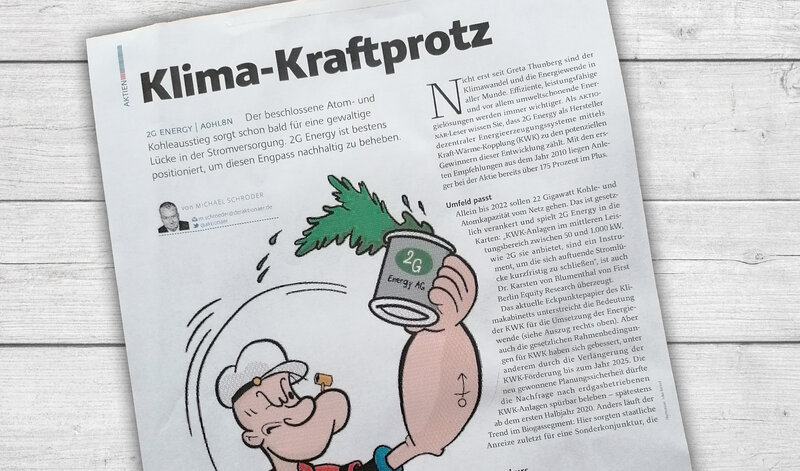More courage for decentralization
August 4, 2025

Christian Grotholt founded 2G Energietechnik GmbH in 1995 together with his partner Ludger Gausling, headquartered in Heek, Münsterland (North Rhine-Westphalia). After the IPO, he served as CEO of 2G Energy AG and will move to the company’s supervisory board on August 1, 2025.
After three decades at the helm of 2G Energy, Christian Grotholt is stepping down from operational management. In conversation with stadt+werk, the co-founder and long-time CEO reflects on his personal journey.
Mr. Grotholt, you are stepping down from your operational role and moving to the supervisory board. What does this step mean for you personally and for the company?
Christian Grotholt: For me, it’s not a complete retreat. I won’t just be sitting on the sidelines, but will continue to contribute my experience and network—through the supervisory board and, prospectively, also as a consultant. I want to continue accompanying 2G Energy, but no longer in an operational role. The past 30 years fill me with gratitude. It has been a privilege to work together with our employees and many partners on the energy transition—in Germany and internationally. A special thanks also goes to our customers, especially the municipal utilities, who often thought more decentrally than some large energy providers—and they did so early on.
Looking back over these 30 years, which milestones were particularly defining for you?
Christian Grotholt: We started out in 1995—just Ludger Gausling and I. He was a master electrician at the time and already had a company. I was allowed to choose the people I wanted to start with from his 30-person team. Some of them are still with us today—that’s what I call lived continuity. A major turning point was the liberalization of the electricity market in 1999: suddenly electricity was dirt cheap, and combined heat and power (CHP) was barely economically viable. The decisive breakthrough came with the first farmer who planned a biogas plant. Our first biogas unit went online in April 2000—right on time for the introduction of the Renewable Energy Act (EEG). The biogas market developed rapidly, especially after the EEG amendment in 2004.
What role did the IPO in 2007 play in the company's development?
Christian Grotholt: That was a milestone—not only for raising capital for research, development, and international expansion, but also for establishing trust with major clients. As a public company, we were transparent and professionally positioned, which was crucial for securing long-term contracts with corporations like RWE or Veolia. In 2008, Günther Herdin, an internationally recognized gas engine expert, joined us. Together, we began experimenting early on with hydrogen-capable solutions. In 2010, we entered into a cooperation with Liebherr for engine platforms, which we refine depending on their application. In 2023, we expanded our portfolio to include high-performance large-scale heat pumps, which will play an important role, especially in municipal heat planning.
Were there setbacks during this time as well?
Christian Grotholt: Of course. The first big doubts arose in 1999 with liberalization. We were a small team and had to improvise. At one point, we even provided electrical installations for a nightclub just to keep the team employed. The only annual loss in our company’s history occurred in 2008, shortly after the IPO and during the financial crisis. That was painful but instructive. And of course, technical development didn’t always go smoothly either.
2G is increasingly becoming a provider of integrated energy solutions. How has the market changed in recent years — and how has your company adapted
Christian Grotholt: We often say: a company must always remain in a state of positive renewal. Anyone who doesn't question themselves will stagnate. Markets are highly regulated, volatile, and vary internationally. That’s why we rely on broad diversification—both technologically and geographically. Digitalization is a key lever in this. We are working on optimizing our systems to automatically adjust to market prices and weather forecasts. Our goal is to unite ecology and economy, contributing to a successful global energy transition with CHP and heat pumps.
How do you see the role of CHP in an increasingly electrified energy system of the future?
Christian Grotholt: CHP is evolving from a grey, base-load workhorse into a green team player. In a system increasingly focused on photovoltaics and heat pumps, it becomes the ideal complement—especially to cover residual loads during dark, cold periods. That’s why we focus on modular, grid-supporting concepts tailored to each location and demand. In consulting, we don't talk about self-sufficiency, but about location-specific, system-supportive solutions, ideally operated by energy service providers or municipal utilities.
What are your expectations for the new federal government, particularly regarding the power plant strategy, CHP Act, and biomass subsidies?
Christian Grotholt: Some good decisions were made in the last legislative period, such as the extension of the CHP Act and the biomass package. But many questions remain open: what happens after the currently tendered three gigawatts for biogas? What’s next for the CHP Act? I advocate for thinking about these topics together: power plant strategy, biogas subsidies, the CHP Act, and municipal heat planning need to be interconnected. Only then can planning security arise.
The new government is again focusing more on large gas power plants. Do you think this is the right approach?
Christian Grotholt: Large power plants have their justification—but only as part of a mix. I think the 20-gigawatt strategy is oversized. A more realistic distribution would be 50/50—centralized and decentralized. Decentralized plants are quicker to build, more flexible, and more efficient. We can deliver within six months, and commissioning takes no more than twelve months, whereas large power plants take seven to eight years. In Ukraine, we recently delivered two gigawatts within a few months together with other German providers. This shows: there is another way. I call on the new Federal Minister of Economic Affairs, Katharina Reiche, to show more courage for decentralization.
Hydrogen is often touted as the key to climate-friendly energy supply. What role does it play in 2G Energy’s plans?
Christian Grotholt: We already have more than 30 plants worldwide running exclusively on hydrogen—from Canada to Taiwan. We are technologically open and also advancing ammonia and propane heat pumps. If, contrary to expectations, fuel cells prove superior in five years, the CHP unit in the container can simply be moved to other countries. This flexibility is our strength. Through our rental options, we offer this solution to energy providers.
Looking to the future: What, in your opinion, should the ideal energy system look like in 15 years?
Christian Grotholt: It requires an intelligent combination of centralized and decentralized plants operated by competent and system-relevant energy providers. Renewable energies form the foundation, complemented by storage and flexible technologies like CHP. The key is: the goal is not self-sufficiency, but location-specific, system-supportive supply—that is the path to a resilient, sustainable energy future.
Interview: Alexander Schaeff, stadt + werk

